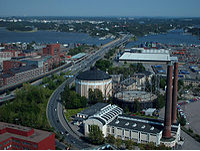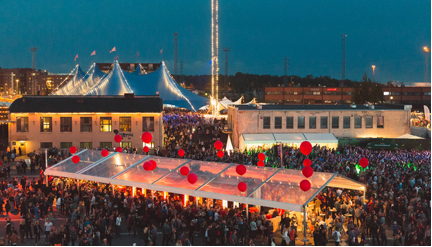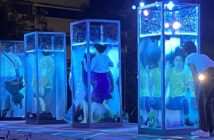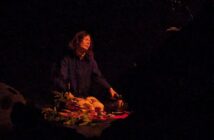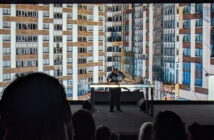This year’ was the 10th edition of the Helsinki Flow Festival, a 3-day event which has grown roughly comparable in size to Sydney’ Big Day Out – which this year attracted 57,000, despite being over 40 degrees. Flow had an estimated 61,500 over three days, including a kiddies’ day on Sunday, and a more moderate temperature of around 20 degrees, which is very warm for Helsinki, and attracted some extraordinary summer apparel. Although I haven’ been to the BDO since Sonic Youth, Iggy Pop, Nick Cave and Mudhoney headlined in 1993 (20 years ago!) Flow is comparable in layout if much vaster in its scope. Ranging from Alicia keys and Jens Lekman (who shared with us some of his experiences of living in Melbourne) on the mainstream pop tip to Nick Cave trying to get up close and personal with the front rows of the audience (can I never get away from Australia?) to My Bloody Valentine deafening us with their wall of sludge in the Nokia Blue Tent, Cat Power with an almost all-female band in the same venue, and Of Monsters and Men playing their 100th show this year, but their first time in Helsinki.
The main event was Kraftwerk’ frankly inane 3D show, which at least served to get everyone wearing 3D glasses (completely unnecessarily most of the time) for photo opportunities highlighting the post-industrial glows of the gathering dusk of the Suvilahti site. Suvilahti is a former 1909 gas and electricity works now converted into artists’ studios, which also houses writers, photographers and advertising companies. There are also future plans to develop an equivalent of the Tate Modern in London in a building slightly reminiscent of the Battersea Power station.
The Suvilahti site in 2006
But I was here to hear some Finnish music, and I wasn’ disappointed, as long as I got there early. First up I saw Pekko Käppi and Juhana Nyrhinen, an extraordinary punk-folk duo, the latter of whom plays the Finnish traditional stringed folk instrument the kantele electrified and constructed from a skateboard, at times with a bottleneck and a drumstick, the former the jouhikko, a Finnish-Karelian horse hair-stringed, bowed lyre (one of which had an imbedded skull with flashing red eyes) and the rapapalli, a birch bark rattle ball. They also produce electronics, and extraordinary sounding folk and murder ballads by Käppi (sung in Finish, of course) which far outdo anything Nick Cave could muster. The duo’ 2010 album Vounna 86, recorded on a 4-track cassette recorder, won the Finnish folk prize, and they have apparently been to Australia in the past, but this was my first encounter with them. It was the performance that stayed longest in my mind over the three days, and I was privileged enough to watch it in comfort in the smallest indoor venue, curated by Fonal Records’ founder Sami Sänpäkkilä, known as “The Other Sound’. This has a capacity of little more than 100, and soon became incredibly hot, cramped and stuffy. Later it attracted a ridiculously large overflow for Blixa Bargeld’ midnight “solo vocal performance’ which I didn’ even bother to stay for. I did catch an all-female guitar trio there on the Sunday, Olimpia Splendid, a Fonal act who looked like teenagers, but managed to coax out some very bending, experimental noises along with some very rasping vocals. They were playing at the same time as Public Enemy were dominating the Main Stage with their old school retro routine (Flavour Flav was even wearing an NWA Straight outta Compton T shirt) which was all way too tired for me. How many times do you need to be told not to “believe the hype’, after 25 years? I guess for some of the local hipsters, fashionistas and Finnish alternative glitterati and longhairs (who very much hold their own in Helsinki with the rest of the world) it might have been a novel experience.
PE certainly got a big build up from Finland’ most prominent MC Paleface, whose consummate wordplay in both English and Finnish starts with his name (his first album was called “The Pale Ontologist’s (http://www.youtube.com/watch?v=iR6UvuE37yY&list=PLBBA7ACBCF5C55152&index=4) and ranks with the best French or US rappers). Paleface was fronting the local Ricky Tick Big Band with two other Finnish language MCs, Redrama and Tommy Lindgren, in what was a hugely entertaining if somewhat surprising combination which had the crowd wowed. I could never imagine this happening at the BDO. The RTBB is a large jazz orchestra in evening (or afternoon) dress, who showcased its few female members on baritone sax, trumpet and trombone, and had the crowd swaying and totally engaged. One of the real highlights. If PE had invited Paleface on stage, he might just have blown them off. Literally, if not figuratively.
… lit up by the Flow Festival
PE also cast a long shadow as they went overtime in what was generally an excellently scheduled festival with few if any late starts. Ironically the group they were holding up and bleeding their noise into was fellow African-Americans Ravi Coltrane and his quintet, who played on the Balloon stage, a circular auditorium just next to the Main Stage with a large helium balloon suspended over it, which was packed to the gills. Coltrane, who is beginning to scale the heights reached by his father, delivered a sublime set which easily outclassed anything else at the festival, closely aided and abetted by alto sax player Steve Coleman, pianist Dave Virelles, and a very large and smiling rhythm section of Dezron Douglas on bass and Jonathan Blake on drums, whose huge enjoyment of the music they were playing was a pleasure to watch. Playing compositions by Charlie Parker as well as Coleman and Coltrane, the quintet transported a hushed crowed into outer realms, giving an object lesson in what playing music in a relaxed, consummate fashion on instruments without any effects is all about. Coltrane played some intense solos on soprano, while Coleman provided able support and a few blistering solos of his own on alto, and the other members all soloed as well, exuding a proficiency and fluidity that was staggering.
On the jazz tip, there were some excellent Finnish players, some of whom were showcased in the Tivistämö, also a Japanese restaurant, a haven of peace and quiet where younger performers like the KOK trio, Trio Urho and Smith and Zenger held residencies. The Black Motor trio is a punk-jazz improvisers’ outfit influenced by Coltrane and Coleman who have released nine albums and played with most of Finland’ jazz elite (Raoul Björkenheim, Iro Haarla, Juhani Aaltonen) as well as German avant-garde sax maestro Peter Brötzmann, who found them “refreshingly gruff’. They recently joined forces with multi-award winning trumpeter Verneri Pohjola, probably Finland’ finest, who toured Australia with his Ilmiekki (“Into the naked Flame) Quartet in 2011. With a bearded sax player in a cowboy hat resembling a cowpunk Warren Ellis, (http://www.youtube.com/watch?v=dprTaQeXRXc) Black Motor come from Tampere, a city that is no slouch for its music, being the home of the Fonal label, who were also present this year with the female underground folksinger Lau Nau, who has made something of a splash in the USA, including in Bruce Springsteen’ home town (http://www.youtube.com/watch?v=5GwXXLsUMU8), and even received the approval of The Wire magazine in the UK, who named her Philadelphia concert in the “60 Concerts that shook the world’ in 2007. This is great for Fonal, but hopefully shows no sign of causing her to switch to singing in English. Lau Nau has also been accompanied by Pekko Käppi on occasions, but here was confined, like him, to the “Other Sound’, which prevented her reaching the wide audience she deserved (Bargeld apparently shot himself in the foot by choosing to perform there). She is also performing at the upcoming Etno-Espa festival in Helsinkia special “Night of the Arts’, so that should bring her some redress.
Among other Finnish perfomers of note the very suave Jaako Laitinen and Väära Raha, an accomplished iskelmä (schlager) outfit, which crosses over with tango, with accordion, trumpet, double bass and vocals,(http://www.youtube.com/watch?v=nLc9ybEVUC8),proved immensely popular with a very stylish bunch of young women who happily danced their butts off at the Balloon stage on Saturday afternoon, and demonstrated again just how wide-ranging this festival’ lineup was. The most popular Finnish iskelmä singer is probably Olavi Virta, “the king of Finnish tango’ who recorded 600 songs and made several films before he died at the age of 57 in 1972, although his career was cut short in 1962 by his arrest on a drunken driving charge, and he died in alcoholic poverty. His music has been revived in Aki Kaurismaki’ early films, most notably the hilarious Calamari Union (1985), in which a group of disillusioned men embark on a perilous, epic odyssey from Kallio, a traditionally working class area of Helsinki not far from the Festival site, to the elite suburb of Eira in the south, which they have heard is a mythical, faraway Utopia of green grass and freedom. Only two survive, only to discover Eira is full of building sites and construction work, so set off in a rowboat to Estonia. And incidentally, given the Finns’ worldwide reputation for alcohol consumption, it might have been the stiff drink prices, which included a returnable deposit on bottles and cans, but there was no evidence of any drunken behaviour, certainly nowhere near the scale of the Big Day Out. But the smoking epidemic is something else.
Helsinki local Jimi Tenor did two sets under the moniker Jimmu along with his partner, New York African-American Cola, one in the “Red Bull Music Academy Backyard’, a fake forest area that actually did boast a few trees, as well as seats made from logs, the other in the Nokia Garage, aka the Boiler Room, with a DJ set-up, which most people seemed to use as a thoroughfare. Tenor looked resplendent in a pink jacket, playing sax, flute, keyboards, electronics as well as DJing and joining in vocals with his spouse, whose songs were about being born in Brooklyn and other such provincial NY concerns, but not Coca Cola, as far as I could tell. Tenor displayed an ambidextrous ease in his role, showing how he is still one of the coolest of Finns. Not to be outdone, Cola fronted her own Finnish-American band in her alter ego as Nicole Willis and the Soul Investigators in the Nokia Blue Tent.
The Black tent was fittingly named for goth, punk and metalheads, although there was little of the latter apart from members of the audience. It also housed the unpleasantly noisy “goth-crunk’ of Yöt, electronic synth band K-X-P, formerly the cult electronic group Op:l Bastards, likewise specialising in rhythmic farting noises, and Pää Kii, old school punksters who concluded with a celebratory anthem about HIV, and whose drummer had just spent the night in the “booze bin’ (ie jail). Then there was Black Lizard, a sort of Jesus and Mary Chain revival band specialising in “rowdy garage rock’, jazz-rockers Dalindèo, as well as more Finnish hip hop, incomprehensible to me, such as Laineen Kasperi and Palava Kaupunki, who have an appealing name, and have been described as “organic hip hop with a live band’. The weirdly costumed Oukkidouppi also appeared, and Jyrki Nissanen, a growling character who is also a comic book artist and painter. There was also the Kallo Collective and Krepsko Theatre group, who combined music with a circus performance involving a large rabbit (played by a human), a character in white on stilts, and two women hanging lethargically in trapezes, one of them occasionally playing an accordion, but in the end there was just too much to investigate. As I began my trek to the Sornäinen metro station on Sunday night, Kraftwerk’ robotik blips filling the air, it was after a very pleasant, mostly relaxed, but very stimulating learning experience. Music in Finland should be as engaging as music in Iceland.
Tony Mitchell

